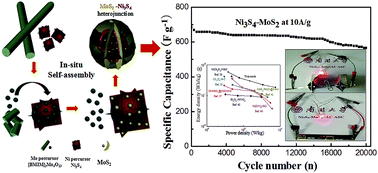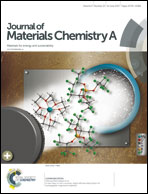One-step extended strategy for the ionic liquid-assisted synthesis of Ni3S4–MoS2 heterojunction electrodes for supercapacitors†
Abstract
A convenient, self-assembly, ionic liquid-assisted method for the preparation of a Ni3S4–MoS2 heterojunction is reported. The Ni3S4 support not only provided high conductivity in the heterojunction for MoS2, but also showed more compatibility with MoS2, allowing a long cycle life. The capacity of the Ni3S4–MoS2 heterojunction is 985.21 F g−1 at a current density of 1 A g−1, and it can retain 573 F g−1 after 20 000 cycles at a current density of 10 A g−1. The Ni3S4–MoS2//AC (ASC) device demonstrated a high energy density of 58.43 W h kg−1 when the power density reached 385.95 W kg−1, and it can retain an energy density of 18.75 W h kg−1 even at a high power density of 7500 W kg−1, revealing its potential and viability for practical applications. Furthermore, this work provides a novel method to synthesize MxSy–MoS2 (M = Co, Mn, etc.) heterojunction materials in one step. These heterojunction materials could be used in a wide range of fields such as in HER catalysts, Li ion batteries and supercapacitor electrodes.



 Please wait while we load your content...
Please wait while we load your content...